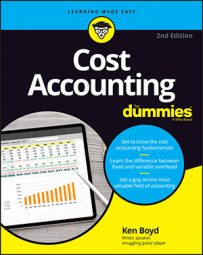In cost accounting, fixed overhead costs are costs that stay the same even as the level of activity changes. Your goal is to reduce fixed overhead costs and generate more profit.
The name of the game for overhead is to look at the activities that cause you to incur cost and decide if those activities are necessary for production. Here are some planning techniques that can prevent and remove unnecessary fixed overhead costs.
Scheduling overhead costs reduces the chance that you’ll pay more because of an emergency. For example, a well-managed manufacturer schedules repair and maintenance on the machinery, because it’s better to maintain equipment rather than to fix it when it breaks down.
Follow a program of scheduled maintenance (also known as preventive maintenance) to keep equipment running in top condition. If you’re running production around the clock to fill an order, you don’t want to lose time waiting for a machine to be fixed.
Schedule your fixed overhead costs in cost accounting
You can use a schedule to reduce your costs and stick to your spending plan. Reducing your costs should help you maintain a reasonable profit level. When you maintain a schedule, you avoid spending money without fully considering the consequences.
You make better decisions about spending when you plan your spending. Buy only what you need to buy, and if possible, buy office supplies and similar items on a schedule.
At the least, develop a purchasing process. For example, perform a monthly review of your office supplies. Based on that review, make a month-end purchase of what you need. One monthly purchase will reduce the likelihood of frequent, unplanned impulse buys of items you don’t really need.
Consider capacity needs in cost accounting
Any asset that you own (equipment, machinery, vehicles, and so forth) has a limit on its use. For example, a car can operate well for only so long. At some point, repairs become excessive. A machine can produce a product only for a certain number of hours per day. That’s the capacity or duty cycle. If you try to operate beyond that level, similar to the car, the machine — or asset — eventually breaks down.
Relevant range defines the maximum amount that you can produce using the asset. Obviously, when you plan fixed overhead costs, you need to consider the relevant range of your assets.
Capacity planning is the process of figuring the production capacity you need to meet changing demand for your products. You must have the necessary assets in place to meet production requirements. Assume you need to produce 20,000 shirts for the month. If your machinery can produce only 15,000 shirts, you’ve got trouble. But you have choices, each one with consequences.
You could buy or lease another machine (which costs some money), or you could turn away some business (which means less revenue). Maybe you find another manufacturer who can help fill the orders (which means more costs to you). As is often attributed to economist Milton Friedman, “There ain’t no such thing as a free lunch.” The better you anticipate production requirements, the better the decisions you make.

